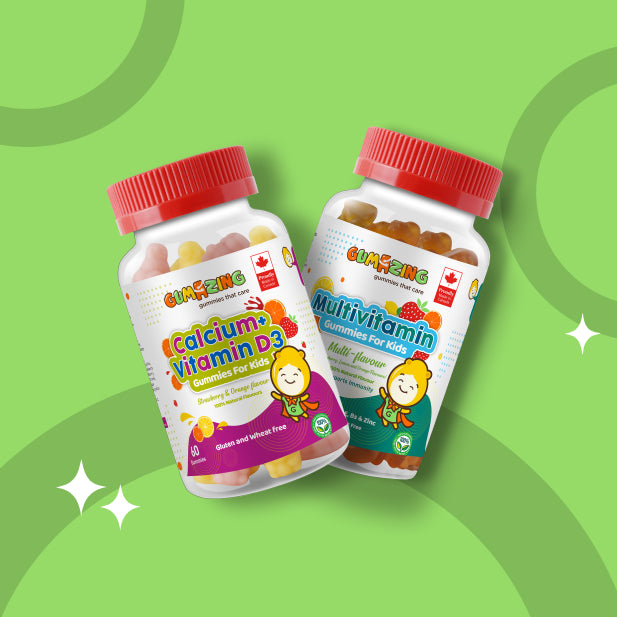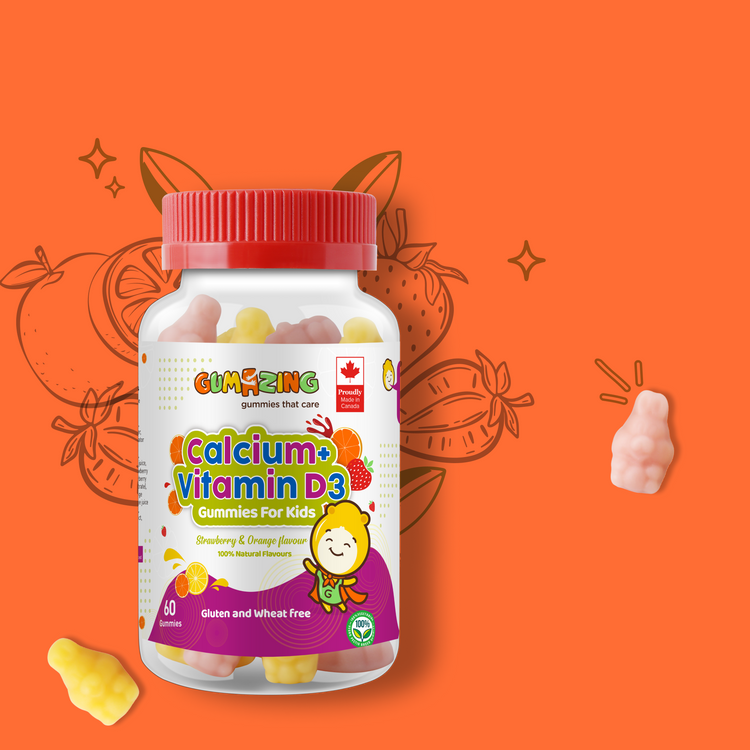Fatigue. Poor appetite. Slower-than-expected growth in children. These aren’t uncommon concerns; they're a reality for many families. Often, the root of the problem isn’t dramatic. It’s missing micronutrients—particularly calcium and Vitamin D supplements, which are central to bone strength and immune balance.
These deficiencies often go unnoticed until signs like growth concerns, reduced immunity, or bone weakness begin to appear. In this blog, we’ll explore how much is truly enough, and where the lines are when it comes to calcium supplements with Vitamin D.
What Do Calcium Supplements With Vitamin D3 Do for Your Body?
Calcium is more than a “bone vitamin.” It's involved in muscle function, blood clotting, and even nerve transmission. Every movement, from a heartbeat to a blink, depends on it. Yet, your body doesn’t make it; you have to consume it. And it doesn’t get absorbed efficiently unless daily Vitamin D intake is adequate. That’s where Vitamin D3 becomes important.
Vitamin D3 supplements act like the gatekeepers. Without them, much of your dietary calcium simply doesn’t get used. D3 helps move calcium from the intestine into the bloodstream, making sure your efforts with food or supplements aren’t wasted. Not getting enough of these nutrients, especially in growing children, may contribute to challenges in bone development and immune health.
Daily Recommended Intake: How Much Should You Take?
Needs change depending on age, diet, gender, and lifestyle. Even in warmer regions, Vitamin D supplements are commonly used, since sun exposure alone may not meet daily needs enough due to indoor habits and skin coverage. Similarly, dairy-free or picky eaters may fall short on calcium.
Here's a revised overview of calcium supplements with Vitamin D guidelines for all ages:
|
Life Stage / Age |
Calcium RDA (mg/day) |
Calcium UL (mg/day) |
Vitamin D₃ RDA (IU/day) |
Vitamin D₃ UL (IU/day) |
|
Infants 0–12 mo |
200–260 |
1,000–1,500 |
400 |
1,000–1,500 |
|
Children 1–3 yr |
700 |
2,500 |
600 |
2,500 |
|
Children 4–8 yr |
1,000 |
2,500 |
600 |
3,000 |
|
Teens 9–18 yr |
1,300 |
3,000 |
600 |
4,000 |
|
Adults 19–50 yr |
1,000 |
2,500 |
600 |
4,000 |
|
Men 51–70 yr |
1,000 |
2,000 |
600 |
4,000 |
|
Women 51+ or Adults 71+ |
1,200 |
2,000 |
800 |
4,000 |
Average intake across many adults doesn’t quite meet the ideal. Reports show that men consume about 1,083 mg and women about 842 mg of calcium daily, from both food and supplements. For daily Vitamin D intake, many fall below even the lower RDA, particularly in South Asian and Middle Eastern populations.
Signs of Calcium and Vitamin D Deficiency
Deficiency signs may not always be obvious. Mild deficiencies may show up as tiredness or leg cramps before they escalate. In kids, it might look like slow bone growth or irritability. What many people don’t realize is that Vitamin D3 deficiency is very common.
Especially in South Asia, where 50–94% of community populations and up to 99% of hospital patients show a deficiency in testing.
Look for signs like:
- Bone pain or frequent fractures
- Muscle weakness or cramps
- Delayed growth or shorter stature
- Constant tiredness, even with rest
- Poor dental health or late tooth eruption
- Irritability, especially in younger age groups
-
Poor immune function or frequent illness
Supplements: When and Why You Might Need Them
Sometimes, food and sunlight just don’t cut it. Whether due to diet, climate, or absorption issues, both calcium and Vitamin D3 supplements can help fill dietary gaps, especially in children and teens who are still developing bone mass.
Limited Sunlight Exposure
Kids who spend most of their time indoors or live in high-rise cities may not get enough UVB rays, which help the skin produce D3.
Restricted Diets
Lactose intolerance, dairy-free diets, or low appetite heavily reduce the natural intake of calcium.
Poor Absorption
Certain health conditions pose a threat to the body's absorption and utilization of calcium and Vitamin D3.
Rapid Growth Periods
During growth spurts, calcium demands soar, and in fact, relying solely on food may not provide an adequate supply.
Preventive Supplementation
In most cases, parents do the supplementation as a preventive measure.
Support your child’s bone health with calcium vitamin D3 gummies. These tasty gummies are packed with essential nutrients like calcium and Vitamin D3, crucial for developing strong bones and teeth. Perfect for growing kids, our gummies make supplementation easy and enjoyable.
Final Thoughts
Getting enough calcium and Vitamin D3 each day is part of maintaining good overall nutrition. Especially during critical developmental years. The good news? It doesn’t require complex meal plans or extreme measures.
With thoughtful choices, supportive products, and clear awareness of age-appropriate intake, bone and immune health become easier to manage.
Is your family getting enough of both? Discover our full range of kid-friendly nutrients at Gumazing, supporting everyday growth, health, and happiness.
FAQs
1. Can I take calcium, but without vitamin D3?
You certainly can do that, but shouldn't. Vitamin D3 actually helps your body efficiently absorb calcium. Calcium may go unused in greater amounts without the presence of Vitamin D3.
2. Are the calcium supplements with vitamin D3 safe to be taken every day?
Yes, for sure, when these supplements are consumed within the recommended amounts. It is advisable to check the advertised dosage to ensure you do not exceed the safe range for your age.
3. How will I know if my child is in need of a supplement?
If the child does not receive enough dairy, sunlight, or if you observe a very slow pace of growth, the supplementation may aid in sustaining nutrition.
4. Does sunlight provide enough vitamin D3?
That may not be the case all the time. Factors such as indoor lifestyle, skin tone, and climate can contribute to a decreased buildup of D3 in your body, particularly when exposure to the sun is limited.



















































